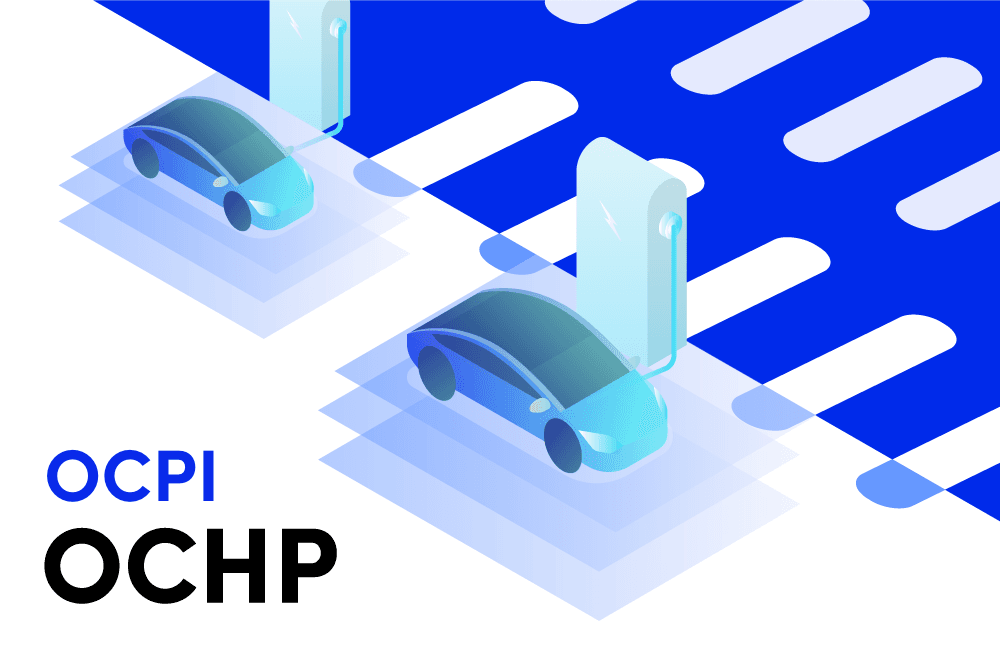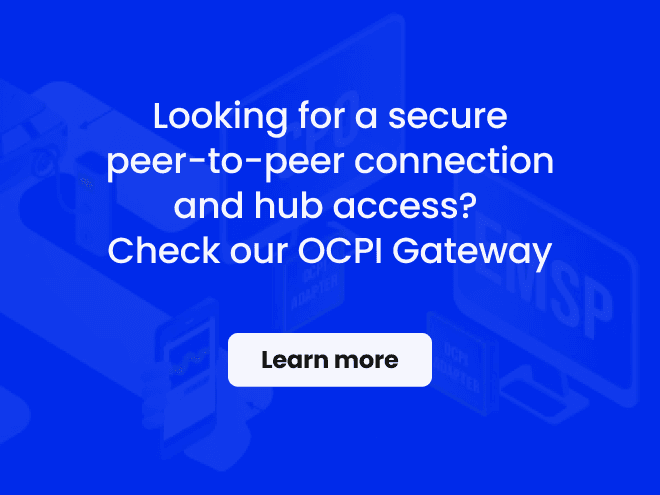EV roaming and its open protocols, like OCPI and OCHP, are helping solve one of the most persistent challenges in electric mobility: fragmented charging experiences.
For many EV drivers, especially when traveling across networks or borders, charging isn't as seamless as it should be. Multiple apps, incompatible systems, and limited network access can get in the way.
This article explores how protocols such as OCPI and OCHP support interoperability, simplify cross-network charging, and enable a more connected EV charging infrastructure.
What is EV roaming?
EV roaming enables electric vehicle drivers to access charging stations outside their primary eMobility Service Provider (eMSP) network. In practice, this means a driver can use a charger operated by a different Charge Point Operator (CPO) without needing a new account, additional app, or separate authentication process.
Behind this convenience is a framework of technical standards and roaming agreements that facilitate real-time data exchange. When a session begins, the driver’s credentials are verified, often through an open EV charging protocol like OCPI or OCHP. Once authorized, data such as session duration, energy usage, and pricing is exchanged between the CPO and eMSP, ensuring proper billing and transparency.
This interoperability reduces friction for drivers, allowing access to a broader EV charging network without the barriers of closed ecosystems. It simplifies the charging experience, encourages broader EV adoption, and supports more efficient use of existing infrastructure. For operators, roaming expands reach, increases station utilization, and aligns with growing expectations for EV charging interoperability.
Why is roaming essential for EV infrastructure?
As electric mobility gains momentum, so do the expectations of EV drivers. A consistent, reliable charging experience regardless of location or network is becoming essential. Without roaming, users are often restricted to closed ecosystems tied to a single eMSP. This limitation becomes especially problematic when crossing city, regional, or national boundaries, where incompatible systems can hinder access.
EV roaming addresses these gaps by enabling interoperability across networks. Through protocols like OCPI and OCHP, drivers can initiate sessions on unfamiliar networks without interruption, simplifying access and reducing range anxiety.
The benefits extend beyond user convenience. For Charge Point Operators (CPOs), roaming increases charger utilization and visibility without the overhead of onboarding every new user. For eMSPs, it enhances platform value by offering a wider, more accessible network, helping build loyalty and trust.
Additionally, roaming supports regulatory compliance. Many public infrastructure policies now require open access and multi-provider support. Roaming ensures these mandates can be met technically and operationally.
In essence, roaming transforms EV charging from a fragmented landscape into a connected ecosystem, supporting user experience and network scalability.
How EV roaming works
EV roaming relies on secure and standardized communication between different systems, allowing EV drivers to access charging stations beyond their primary provider’s network, without added complexity.
This process involves multiple parties: the driver, their eMSP, the CPO, and sometimes a central roaming hub. These actors exchange data using open EV charging protocols like OCPI or OCHP to coordinate identity verification, session authorization, real-time pricing, and billing.
A typical EV roaming session includes:
- Session start: The driver initiates charging via an RFID card or app provided by their eMSP.
- Authorization: The CPO checks whether the user is valid, either directly with the eMSP or via a roaming hub.
- Charging: Once approved, the session begins. Data about usage, tariff, and duration is tracked.
- Billing: At the end of the session, the CPO sends a Charge Detail Record (CDR) to the eMSP for reconciliation.
This exchange must happen quickly, accurately, and securely. In hub-based models, a platform like e-clearing.net handles routing and validation. In peer-to-peer setups, enabled by OCPI, data flows directly between systems. Some networks also blend both approaches to meet varying regional or commercial needs.
The key outcome? The technical complexity is hidden from the driver. They simply charge, no matter whose infrastructure they’re using.
OCPI: Open Charge Point Interface
The Open Charge Point Interface (OCPI) is a widely adopted open protocol that enables seamless, peer-to-peer EV roaming. Developed by eViolin and now maintained by the EVRoaming Foundation, OCPI enables direct communication between eMobility Service Providers (eMSPs) and Charge Point Operators (CPOs) without relying on a central intermediary.
Designed for flexibility and scalability, OCPI supports a decentralized model where providers can establish and manage bilateral roaming partnerships on their terms. This approach offers commercial freedom, data ownership, and greater control over integration architecture.
Key capabilities of the OCPI protocol include:
- Authentication and authorization of drivers using real-time checks or static whitelists.
- Exchange of session data, including Charge Detail Records (CDRs), to support accurate billing and reporting.
- Transparent pricing, enabling pre-session access to tariff and location-specific cost details.
- Real-time station data, such as charger availability and power output.
- Smart charging features support dynamic control based on user preferences or grid demand.
OCPI is built on a RESTful API structure using JSON, making it accessible for modern development teams. Its modular design allows companies to implement specific features based on user needs, streamlining adoption without overengineering.
In practice, OCPI has seen widespread use across Europe, including the Netherlands, Germany, Poland, and France, and continues to expand into global markets. It also supports regulatory requirements such as Germany’s Eichrecht law, which mandates secure and auditable metering data.
For organizations seeking an open EV charging protocol that supports interoperability, customization, and cross-border scalability, OCPI is a proven and future-ready solution.
OCHP and OCHPDirect: Roaming through a central hub
While OCPI enables direct, decentralized roaming, the Open Clearing House Protocol (OCHP) supports a centralized approach to EV roaming, one that prioritizes simplicity, stability, and streamlined integration.
Smartlab Innovationsgesellschaft and ElaadNL develop OCHP, and it underpins platforms like e-clearing.net, a neutral roaming hub that facilitates data exchange between Charge Point Operators (CPOs), eMobility Service Providers (eMSPs), and even Navigation Service Providers (NSPs).
Unlike peer-to-peer models, OCHP allows each party to connect once to the hub, which routes data, manages authorizations, and forwards billing records. This “connect once, reach many” model significantly reduces the onboarding burden for new participants.
Technical and operational features of the OCHP protocol:
- SOAP-based communication supporting asynchronous data transfer and batch processing.
- Authorization via static whitelists ensures that charging sessions can proceed even during temporary network or hub outages.
- Central handling of Charge Detail Records (CDRs) for session validation and billing reconciliation.
- Exchange of pricing, charger availability, and location data through standardized formats.
To enable more dynamic interactions, OCHPDirect extends the base protocol with support for real-time data flows. This includes capabilities such as remote session control, smart charging adjustments, and live metering, while still leveraging the underlying hub structure.
This combination offers the best of both worlds: the structured coordination of a central hub with the agility of selective direct integrations. It’s particularly valuable for public sector projects, smaller operators, or national-scale programs looking for efficient ways to scale roaming capabilities.
For providers focused on governance, policy alignment, and ease of integration, OCHP represents a practical and robust foundation for EV roaming.
OCPI vs. OCHP: Protocol comparison
OCPI and OCHP both serve the same overarching purpose—enabling EV roaming between eMSPs and CPOs—but they differ significantly in how they approach integration, communication, and scalability.
OCPI is based on a peer-to-peer model. It allows eMSPs and CPOs to connect directly without a central intermediary. This approach gives operators more control over commercial agreements, data handling, and feature implementation. It’s built using RESTful APIs and JSON, supporting real-time, modular communication. This makes it ideal for flexible and scalable roaming setups where rapid innovation or bespoke partnerships are a priority.
OCHP, by contrast, is built on a centralized hub-and-spoke model. All participants connect once to a central platform, typically e-clearing.net, which facilitates communication. OCHP uses SOAP-based messaging and focuses on asynchronous, batch-style data exchange. This model simplifies onboarding and is particularly effective for standardized, policy-driven infrastructure, such as national EV programs or municipal tenders.
OCHPDirect, an extension of OCHP, enables real-time data exchange within a hub-based setup. It allows operators to implement features like remote session control and smart charging without giving up the centralized integration model.
OCPI offers flexibility and customization, making it suitable for fast-moving commercial platforms. OCHP provides structure and ease of integration, ideal for public sector and regulatory-driven environments. Many networks choose to support both, combining the scale and simplicity of OCHP with the agility of OCPI to meet diverse operational needs.
EV Roaming in action: A regulatory push
The growth of EV roaming is not only driven by market demand and technological innovation, but it’s increasingly being shaped by regulation. Across Europe and beyond, governments are setting clear requirements for interoperability, making roaming capabilities a condition for public infrastructure deployment.
The rationale is simple: a fragmented charging ecosystem limits access, slows adoption, and undermines sustainability goals. To address this, policies are emerging that mandate open access and enforce compliance with recognized roaming standards like OCPI and OCHP.
Take Slovakia, for example. New public charging points must connect to a roaming platform that provides access to at least 80 operators, within just three months of commissioning. This ensures national-scale interoperability from the start.
In Germany, cities like Berlin require public CPOs to register with centralized platforms for user authentication. This guarantees fair and open access, regardless of which eMobility Service Provider a driver uses, while improving regulatory oversight.
Oslo has embedded openness into its infrastructure contracts. The city mandates that data on pricing, charger availability, and access be made available to third parties, promoting innovation in EV services, navigation, and urban mobility planning.
These are not isolated measures. They reflect a broader trend toward standardization and compliance, aligned with the European Union’s Green Deal and 2050 climate targets. Interoperability, once a technical preference, is now becoming a legal and operational requirement.
Protocols like OCPI and OCHP provide the technical foundation for meeting these expectations. They support seamless data exchange, identity verification, session tracking, and billing transparency, ensuring that roaming networks meet both business needs and regulatory standards.
Building a roaming-ready EV network: What you need to know
As EV adoption accelerates and regulatory expectations evolve, the need for a roaming-ready infrastructure has shifted from optional to essential. Whether you're a CPO, an eMSP, or a platform developer, supporting EV roaming is now a baseline requirement for participation in modern electric mobility ecosystems.
For CPOs, enabling roaming means greater visibility and increased utilization of charging assets. By making stations accessible to a wider pool of drivers—regardless of their eMSP—you improve return on investment and enhance your position in public or competitive tenders. Protocols like OCPI allow you to form direct partnerships with service providers, while OCHP provides a fast track to scale through established hub networks.
For eMSPs, roaming is about delivering a seamless, trustworthy charging experience. Your users expect to charge their vehicles without friction, even when they cross a city, region, or national border. Integrating roaming through OCPI offers flexibility to tailor commercial agreements and user flows, while OCHP ensures quick access to a broad charging footprint via hub connectivity.
For platform developers and software providers, roaming support should be built into the architecture from day one. Your clients need modular, scalable, and protocol-ready systems, capable of handling integrations across OCPI, OCHP, and evolving standards. A future-proof platform enables faster go-to-market, easier compliance, and adaptability across regions and use cases.
Across the board, the key message is clear: it’s not about whether to support roaming, but how well and quickly it can be implemented. Operators that embrace roaming will be better positioned to meet regulatory benchmarks, serve a growing user base, and scale sustainably in an increasingly competitive market.
Building for scale: Why interoperability is the future of EV charging
EV roaming is no longer a nice-to-have feature—it’s a core component of modern charging infrastructure. Whether enabled through the flexibility of OCPI or the streamlined approach of OCHP, open protocols are what make seamless, interoperable charging possible. They provide the technical and commercial foundation for scaling networks, improving driver experience, and complying with growing regulatory requirements.
For Charge Point Operators, roaming expands your customer base and enhances infrastructure efficiency. For eMobility Service Providers, it strengthens your value proposition by offering consistent, cross-network access. And for platform builders, it’s a must-have capability that ensures long-term adaptability.
As electric mobility moves forward, interoperability will define which platforms grow and which get left behind.
How Solidstudio can help
At Solidstudio, we specialize in developing future-ready, protocol-compliant EV software. Whether you're preparing your first OCPI integration or scaling a national OCHP-connected network, we help you:
- Design and implement OCPI and OCHP integrations
- Build scalable, modular backend platforms
- Navigate compliance and interoperability standards
- Streamline CDR handling, smart charging logic, and platform performance
We work with CPOs, eMSPs, and mobility platforms across Europe and beyond, helping them launch faster, integrate more effectively, and grow with confidence.
👉 Get in touch to discuss your roaming strategy.
📘 Or explore more in our free eBook: Exploring EV Charging Software


